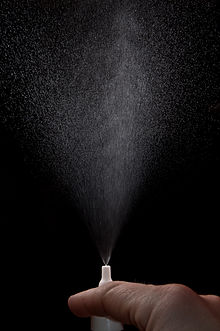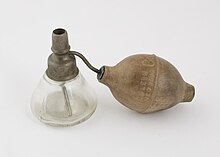
Back فوهة رش Arabic Ajuto Esperanto افشانک Persian Buse (tuyère) French נחיר רסס HE कणित्र Hindi Ugello spruzzatore Italian Бүріккіш Kazakh Purkštukas Lithuanian Muncung sembur Malay
This article needs additional citations for verification. (December 2015) |




A spray nozzle or atomizer is a device that facilitates the dispersion of a liquid by the formation of a spray. The production of a spray requires the fragmentation of liquid structures, such as liquid sheets or ligaments, into droplets, often by using kinetic energy to overcome the cost of creating additional surface area. A wide variety of spray nozzles exist, that make use of one or multiple liquid breakup mechanisms, which can be divided into three categories: liquid sheet breakup, jets and capillary waves. Spray nozzles are of great importance for many applications, where the spray nozzle is designed to have the right spray characteristics.[1]
Spray nozzles can have one or more outlets; a multiple outlet nozzle is known as a compound nozzle. Multiple outlets on nozzles are present on spray balls, which have been used in the brewing industry for many years for cleaning casks and kegs.[2] Spray nozzles range from those for heavy duty industrial uses to light duty spray cans or spray bottles.[3]
- ^ Nasr, Yule and Bending, "Industrial Sprays and Atomization", Springer, 2002, ISBN 1-85233-611-0
- ^ Kennedy/Jenks Consultants "Water Use Efficiency Report" https://clfp.com/wp-content/uploads/CLFP_Water-Use-Efficiency-Study_02-11-15_PART-3.pdf
- ^ US 5941462, Sandor, Joseph, "Variable spray nozzle for product sprayer", published 1999-08-24, assigned to John R. Woods